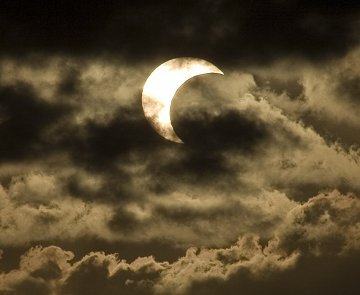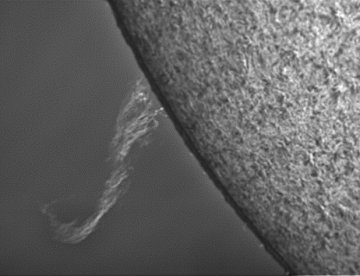 Autumn is here, and it's a wonderful time for stargazing. Find out what's up from Spaceweather PHONE.
Autumn is here, and it's a wonderful time for stargazing. Find out what's up from Spaceweather PHONE.
SURPRISES FROM THE EDGE: NASA's Voyager 1 spacecraft has entered a new realm of space, and it's beaming back some surprises. Get the full story from Science@NASA.
BAD SUN RISING: "The horizon was cloudy when the sun rose this morning," says David Marshall of Christ Church, Barbados, "but thankfully some gaps appeared" revealing this strange spectacle:

"I call the shot 'Bad Sun Rising,'" says Marshall.
The same "Bad Sun" was seen hovering over most of South America and parts of Africa: map. What happened? The Moon passed in front of the sun turning the usual orb into a crescent or, in a few places, a vivid 360-degree ring of fire. Click for more pictures:
Solar Eclipse Photo Gallery
MORE SOLAR SHAPES: Once again today, the sun is displaying a nice variety of prominences for onlookers with solar telescopes. "This one with its sweeping lines and curves just looked so graceful and delicate," says Pat Stoker of Anaheim California:

Prominences are clouds of hydrogen held up and sculpted by solar magnetic fields. They can take almost any shape, limited mainly by the imagination of the observer: Greg Piepol of Rockville, Maryland, looked at Stoker's prominence through his own telescope and saw a snake poised to strike; John Stetson of Falmouth, Maine, felt it was more like a twister; while Erika Rix's pencil-and-crayon sketch resembles an angry dragon. What's next? Stay tuned.
UPDATE: "I took a quick peek through my PST this afternoon and noticed a huge and very dynamic prominence," says Trevor Durity of Galway City, Ireland. "I rushed inside to get my notebook and captured this image."

